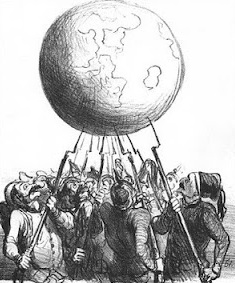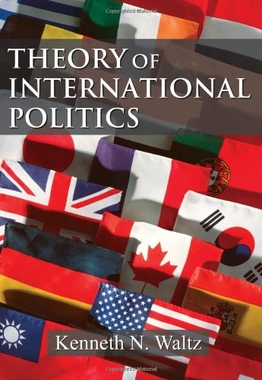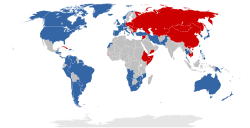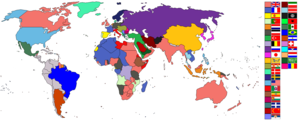Neorealism or structural realism is a theory of international relations that emphasizes the role of power politics in international relations, sees competition and conflict as enduring features and sees limited potential for cooperation. The anarchic state of the international system means that states cannot be certain of other states' intentions and their security, thus prompting them to engage in power politics.

Hegemony is the political, economic, and military predominance of one state over other states, either regional or global.

International relations (IR) are the interactions among sovereign states. The scientific study of those interactions is also referred to as international studies, international politics, or international affairs. In a broader sense, the study of IR, in addition to multilateral relations, concerns all activities among states—such as war, diplomacy, trade, and foreign policy—as well as relations with and among other international actors, such as intergovernmental organizations (IGOs), international nongovernmental organizations (INGOs), international legal bodies, and multinational corporations (MNCs). There are several schools of thought within IR, of which the most prominent are realism, liberalism and constructivism.
In international relations, power is defined in several different ways. Material definitions of state power emphasize economic and military power. Other definitions of power emphasize the ability to structure and constitute the nature of social relations between actors. Power is an attribute of particular actors in their interactions, as well as a social process that constitutes the social identities and capacities of actors.
In international relations, the liberal international order (LIO), describes a set of global, rule-based, structured relationships based on political liberalism, economic liberalism and liberal internationalism since the late 1940s. More specifically, it entails international cooperation through multilateral institutions and is constituted by human equality, open markets, security cooperation, promotion of liberal democracy, and monetary cooperation. The order was established in the aftermath of World War II, led in large part by the United States.
Grand strategy or high strategy is a state's strategy of how means can be used to advance and achieve national interests in the long-term. Issues of grand strategy typically include the choice of military doctrine, force structure and alliances, as well as economic relations, diplomatic behavior, and methods to extract or mobilize resources.

John Joseph Mearsheimer is an American political scientist and international relations scholar who belongs to the realist school of thought. He is the R. Wendell Harrison Distinguished Service Professor at the University of Chicago.
The concept of balancing derives from the balance of power theory, the most influential theory from the realist school of thought, which assumes that a formation of hegemony in a multistate system is unattainable since hegemony is perceived as a threat by other states, causing them to engage in balancing against a potential hegemon.
Hegemonic stability theory (HST) is a theory of international relations, rooted in research from the fields of political science, economics, and history. HST indicates that the international system is more likely to remain stable when a single state is the dominant world power, or hegemon. Thus, the end of hegemony diminishes the stability of the international system. As evidence for the stability of hegemony, proponents of HST frequently point to the Pax Britannica and Pax Americana, as well as the instability prior to World War I and the instability of the interwar period.

Realism, a school of thought in international relations theory, is a theoretical framework that views world politics as an enduring competition among self-interested states vying for power and positioning within an anarchic global system devoid of a centralized authority. It centers on states as rational primary actors navigating a system shaped by power politics, national interest, and a pursuit of security and self-preservation.
Offensive realism is a structural theory in international relations that belongs to the neorealist school of thought and was put forward by the political scholar John Mearsheimer in response to defensive realism. Offensive realism holds that the anarchic nature of the international system is responsible for the promotion of aggressive state behavior in international politics. The theory fundamentally differs from defensive realism by depicting great powers as power-maximizing revisionists privileging buck-passing and self-promotion over balancing strategies in their consistent aim to dominate the international system. The theory brings important alternative contributions for the study and understanding of international relations but remains the subject of criticism.

The balance of power theory in international relations suggests that states may secure their survival by preventing any one state from gaining enough military power to dominate all others. If one state becomes much stronger, the theory predicts it will take advantage of its weaker neighbors, thereby driving them to unite in a defensive coalition. Some realists maintain that a balance-of-power system is more stable than one with a dominant state, as aggression is unprofitable when there is equilibrium of power between rival coalitions.

William Curti Wohlforth is the Daniel Webster Professor of Government in the Dartmouth College Department of Government, of which he was chair for three academic years (2006-2009). Wohlforth was Editor-in-chief of Security Studies from 2008 to 2011. He is linked to the Neoclassical realism school and known for his work on American unipolarity.
Liberal internationalism is a foreign policy doctrine that supports international institutions, open markets, cooperative security and liberal democracy. At its core, it holds that states should participate in international institutions that uphold rules-based norms, promote liberal democracy and facilitate cooperation on transnational problems.

Theory of International Politics is a 1979 book on international relations theory by Kenneth Waltz that creates a structural realist theory, neorealism, to explain international relations. Taking into account the influence of neoclassical economic theory, Waltz argued that the fundamental "ordering principle" (p. 88) of the international political system is anarchy, which is defined by the presence of "functionally undifferentiated" (p. 97) individual state actors lacking "relations of super- and subordination" (p. 88) that are distinguished only by their varying capabilities.

The Tragedy of Great Power Politics is a book by the American scholar John Mearsheimer on the subject of international relations theory published by W.W. Norton & Company in 2001. Mearsheimer explains and argues for his theory of "offensive realism" by stating its key assumptions, evolution from early realist theory, and its predictive capability. An article adapted from the book had previously been published by Foreign Affairs.
Liberal institutionalism is a theory of international relations that holds that international cooperation between states is feasible and sustainable, and that such cooperation can reduce conflict and competition. Neoliberalism is a revised version of liberalism. Alongside neorealism, liberal institutionalism is one of the two most influential contemporary approaches to international relations.
Charles Louis Glaser is a scholar of international relations theory, known for his work on defensive realism, as well as nuclear strategy. He is the founding director of the Institute for Security and Conflict Studies at the George Washington University's Elliott School of International Affairs, as well as a professor of political science and international affairs. His best-known book, Rational Theory of International Politics: The Logic of Competition and Cooperation received an Honorable Mention for 2011 Best Book from the International Security Studies Section of the International Studies Association.
In international relations, international order refers to patterned or structured relationships between actors on the international level.
Carla Norrlöf is a Swedish-Ethiopian political scientist. She is Associate Professor of Political Science at the University of Toronto. Her research focuses on hegemony, as well as the international political economy of trade, investment and security. Her 2010 book America's Global Advantage: US Hegemony and International Cooperation argues that US hegemony is durable because of its dominance in currency, trade and security. She also argues that the US does not buttress the international system out of altruism, but rather because it derives considerable concrete benefits in being the world's reserve currency, dominant military power, and primary supporter of international markets.











